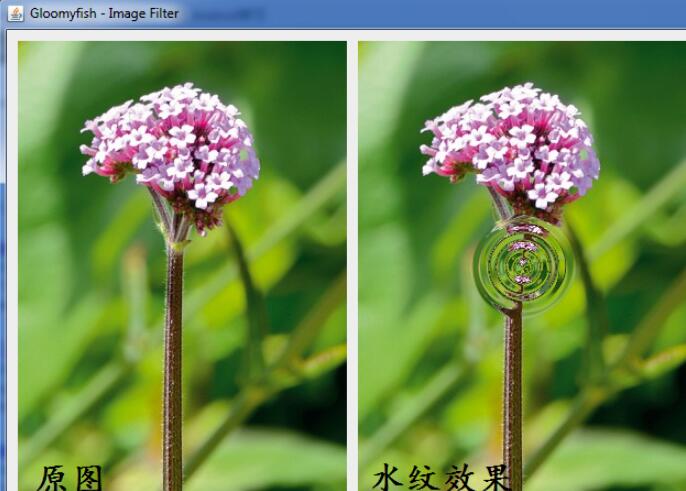溫馨提示×
您好,登錄后才能下訂單哦!
點擊 登錄注冊 即表示同意《億速云用戶服務條款》
您好,登錄后才能下訂單哦!
這篇文章給大家分享的是有關java如何實現水波紋擴散效果的內容。小編覺得挺實用的,因此分享給大家做個參考,一起跟隨小編過來看看吧。
一、原理
模擬水波紋效果,最常見的是sine或者cosn的函數,周期性變化,貼近自然。
當水波紋中中間開始向四周擴散的時候,一般都是慢慢的失去能量,振幅也是越來越小,所以程序要模擬這個過程時候,要加上一個能量遞減因子。然后用公式 y = a*sine(bx + c)來表示波紋公式。
二、程序實現
最重要的一步是計算水波紋的振幅。在任意一點確定水波的中心位置,可以是鼠標隨機選取,對半徑范圍內的像素位置實現水波生成,然后轉換為位置,對位置實現浮點數取整,然后使用適當的插值算法,本例使用雙線性插值。
三、程序效果

四、濾鏡完全源代碼
這次我寫了些中文注解,不給源代碼的博文不是好博文
package com.gloomyfish.filter.study;
import java.awt.image.BufferedImage;
public class WaterFilter extends AbstractBufferedImageOp {
private float wavelength = 16;
private float amplitude = 10;
private float phase = 0;
private float centreX = 0.5f;
private float centreY = 0.5f;
private float radius = 50;
private float radius2 = 0;
private float icentreX;
private float icentreY;
public WaterFilter() {
}
@Override
public BufferedImage filter(BufferedImage src, BufferedImage dest) {
int width = src.getWidth();
int height = src.getHeight();
if ( dest == null )
dest = createCompatibleDestImage( src, null );
int[] inPixels = new int[width*height];
int[] outPixels = new int[width*height];
getRGB( src, 0, 0, width, height, inPixels );
icentreX = width * centreX;
icentreY = height * centreY;
if ( radius == 0 )
radius = Math.min(icentreX, icentreY);
radius2 = radius*radius;
int index = 0;
float[] out = new float[2];
for(int row=0; row<height; row++) {
for(int col=0; col<width; col++) {
index = row * width + col;
// 獲取水波的擴散位置,最重要的一步
generateWaterRipples(col, row, out);
int srcX = (int)Math.floor( out[0] );
int srcY = (int)Math.floor( out[1] );
float xWeight = out[0]-srcX;
float yWeight = out[1]-srcY;
int nw, ne, sw, se;
// 獲取周圍四個像素,插值用,
if ( srcX >= 0 && srcX < width-1 && srcY >= 0 && srcY < height-1) {
// Easy case, all corners are in the image
int i = width*srcY + srcX;
nw = inPixels[i];
ne = inPixels[i+1];
sw = inPixels[i+width];
se = inPixels[i+width+1];
} else {
// Some of the corners are off the image
nw = getPixel( inPixels, srcX, srcY, width, height );
ne = getPixel( inPixels, srcX+1, srcY, width, height );
sw = getPixel( inPixels, srcX, srcY+1, width, height );
se = getPixel( inPixels, srcX+1, srcY+1, width, height );
}
// 取得對應的振幅位置P(x, y)的像素,使用雙線性插值
/*if(xWeight >=0 || yWeight >= 0)
{
outPixels[index] = ImageMath.bilinearInterpolate(xWeight, yWeight, nw, ne, sw, se);
}
else
{
outPixels[index] = inPixels[index];
}*/
outPixels[index] = ImageMath.bilinearInterpolate(xWeight, yWeight, nw, ne, sw, se);
}
}
setRGB( dest, 0, 0, width, height, outPixels );
return dest;
}
private int getPixel(int[] pixels, int x, int y, int width, int height) {
if (x < 0 || x >= width || y < 0 || y >= height) {
return 0; // 有點暴力啦,懶得管啦
}
return pixels[ y*width+x ];
}
protected void generateWaterRipples(int x, int y, float[] out) {
float dx = x-icentreX;
float dy = y-icentreY;
float distance2 = dx*dx + dy*dy;
// 確定 water ripple的半徑,如果在半徑之外,就直接獲取原來位置,不用計算遷移量
if (distance2 > radius2) {
out[0] = x;
out[1] = y;
} else {
// 如果在radius半徑之內,計算出來
float distance = (float)Math.sqrt(distance2);
// 計算改點振幅
float amount = amplitude * (float)Math.sin(distance / wavelength * ImageMath.TWO_PI - phase);
// 計算能量損失,
amount *= (radius-distance)/radius; // 計算能量損失,
if ( distance != 0 )
amount *= wavelength/distance;
// 得到water ripple 最終遷移位置
out[0] = x + dx*amount;
out[1] = y + dy*amount;
}
}
}感謝各位的閱讀!關于“java如何實現水波紋擴散效果”這篇文章就分享到這里了,希望以上內容可以對大家有一定的幫助,讓大家可以學到更多知識,如果覺得文章不錯,可以把它分享出去讓更多的人看到吧!
免責聲明:本站發布的內容(圖片、視頻和文字)以原創、轉載和分享為主,文章觀點不代表本網站立場,如果涉及侵權請聯系站長郵箱:is@yisu.com進行舉報,并提供相關證據,一經查實,將立刻刪除涉嫌侵權內容。